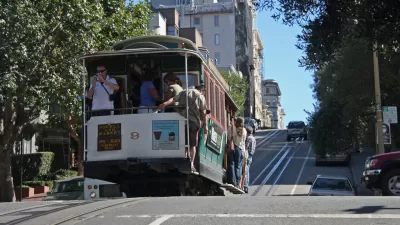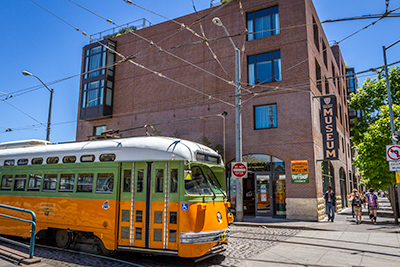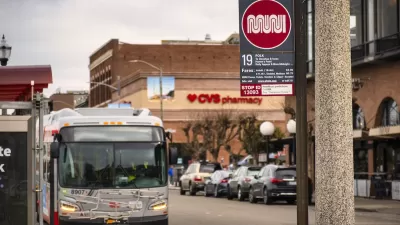As Joe Fitzgerald Rodriguez of the San Francisco Examiner explains, the 'E' Line has only been over three decades in the making. Credit goes greatly to former mayor, now U.S. Senator Diane Feinstein, and the tireless work of committed advocates.

San Francisco's historic or vintage streetcar line is about to double in size. The crowded F Line, operating from Castro Street to Fisherman's Wharf, will soon be sharing streetcars and tracks with its sister line, the E-Embarcadero Line, operating from the Caltrain station, past AT&T (San Francisco Giants) ballpark, merging with the F Line at the Ferry Building, and continuing to Fisherman's Wharf.
Credit: San Francisco Railway Museum • On the F-Line • Steuart St. Stop
"Originally conceived by San Francisco Tomorrow in the 1970s, it wasn’t until [U.S. Sen. Dianne Feinstein, then-San Francisco mayor] backed the project in the ’80s that the trolley’s future was secured," writes Joe Fitzgerald Rodriguez for the San Francisco Examiner.
"It takes a tremendous amount of patience to make dreams come true in San Francisco,” said Rick Laubscher, president of the Market Street Railway Association, a "non-profit group dedicated to the acquisition, restoration and operation of historic transit vehicles in the city," according to the San Francisco Municipal Transportation Authority (SFMTA), the city's public transit operator.
Rodriguez does an excellent job of explaining the history behind the E Line, crediting those who made it happen; so much so that Market Street Railway wrote their own article, "Great E-line Startup Piece in The Examiner." The new E Line will operate on weekends only beginning August 1 with daily service to start next year. Joe Fitzgerald Rodriguez fittingly provides the recent history for the historic line.
"Right after this shot was snapped, Mayor Dianne Feinstein (left) took the controls of Muni Car No.1 and personally piloted it down Market Street to open the first Trolley Festival in June 1983. That success led to the permanent F-line, and now the E-line." Credit: Market Street Railway.
Feinstein's role can not be downplayed. Just as Mayor Michael Bloomberg played an instrumental role in the creation of New York's High Line after his predecessor, Mayor Rudolph Giuliani, tried to kill it, as noted here, Feinstein, working with MTA and Market Street Railway got the F Line, and now the E Line, launched.
“I congratulate the SFMTA on finally achieving this milestone, one we envisioned when I was Mayor,” Feinstein wrote in an email to the Examiner. “Most especially, I am extremely proud of the Market Street Railway Association, led by Rick Laubscher, for their tireless advocacy; without their support, this never would have come to fruition. Now, onto the next challenge — extend the line from Fisherman’s Wharf to Fort Mason!”
On that last note, she refers to an extension from Fisherman's Wharf "through an old tunnel that links Aquatic Park to Fort Mason." The Environmental Impact Statement [PDF] has been completed.
Unlike other historic or replica streetcar lines, San Francisco's streetcars operates more like the oldest public transit in the United States, the New Orleans streetcars, as it serves the local population as well as tourists, as explained here last August.
FULL STORY: Muni set to roll out long-planned waterfront streetcar, the E-line

Alabama: Trump Terminates Settlements for Black Communities Harmed By Raw Sewage
Trump deemed the landmark civil rights agreement “illegal DEI and environmental justice policy.”

Planetizen Federal Action Tracker
A weekly monitor of how Trump’s orders and actions are impacting planners and planning in America.

The 120 Year Old Tiny Home Villages That Sheltered San Francisco’s Earthquake Refugees
More than a century ago, San Francisco mobilized to house thousands of residents displaced by the 1906 earthquake. Could their strategy offer a model for the present?

In Both Crashes and Crime, Public Transportation is Far Safer than Driving
Contrary to popular assumptions, public transportation has far lower crash and crime rates than automobile travel. For safer communities, improve and encourage transit travel.

Report: Zoning Reforms Should Complement Nashville’s Ambitious Transit Plan
Without reform, restrictive zoning codes will limit the impact of the city’s planned transit expansion and could exclude some of the residents who depend on transit the most.

Judge Orders Release of Frozen IRA, IIJA Funding
The decision is a victory for environmental groups who charged that freezing funds for critical infrastructure and disaster response programs caused “real and irreparable harm” to communities.
Urban Design for Planners 1: Software Tools
This six-course series explores essential urban design concepts using open source software and equips planners with the tools they need to participate fully in the urban design process.
Planning for Universal Design
Learn the tools for implementing Universal Design in planning regulations.
Clanton & Associates, Inc.
Jessamine County Fiscal Court
Institute for Housing and Urban Development Studies (IHS)
City of Grandview
Harvard GSD Executive Education
Toledo-Lucas County Plan Commissions
Salt Lake City
NYU Wagner Graduate School of Public Service






























